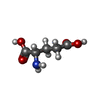+Search query
-Structure paper
| Title | Molecular basis for redox control by the human cystine/glutamate antiporter system xc. |
|---|---|
| Journal, issue, pages | Nat Commun, Vol. 12, Issue 1, Page 7147, Year 2021 |
| Publish date | Dec 8, 2021 |
 Authors Authors | Joanne L Parker / Justin C Deme / Dimitrios Kolokouris / Gabriel Kuteyi / Philip C Biggin / Susan M Lea / Simon Newstead /   |
| PubMed Abstract | Cysteine plays an essential role in cellular redox homoeostasis as a key constituent of the tripeptide glutathione (GSH). A rate limiting step in cellular GSH synthesis is the availability of ...Cysteine plays an essential role in cellular redox homoeostasis as a key constituent of the tripeptide glutathione (GSH). A rate limiting step in cellular GSH synthesis is the availability of cysteine. However, circulating cysteine exists in the blood as the oxidised di-peptide cystine, requiring specialised transport systems for its import into the cell. System xc is a dedicated cystine transporter, importing cystine in exchange for intracellular glutamate. To counteract elevated levels of reactive oxygen species in cancerous cells system xc is frequently upregulated, making it an attractive target for anticancer therapies. However, the molecular basis for ligand recognition remains elusive, hampering efforts to specifically target this transport system. Here we present the cryo-EM structure of system xc in both the apo and glutamate bound states. Structural comparisons reveal an allosteric mechanism for ligand discrimination, supported by molecular dynamics and cell-based assays, establishing a mechanism for cystine transport in human cells. |
 External links External links |  Nat Commun / Nat Commun /  PubMed:34880232 / PubMed:34880232 /  PubMed Central PubMed Central |
| Methods | EM (single particle) |
| Resolution | 3.4 - 3.7 Å |
| Structure data | EMDB-13266, PDB-7p9u: EMDB-13267, PDB-7p9v: |
| Chemicals |  ChemComp-GLU: |
| Source |
|
 Keywords Keywords | MEMBRANE PROTEIN / transporter glutamate cystine |
 Movie
Movie Controller
Controller Structure viewers
Structure viewers About Yorodumi Papers
About Yorodumi Papers







 homo sapiens (human)
homo sapiens (human)